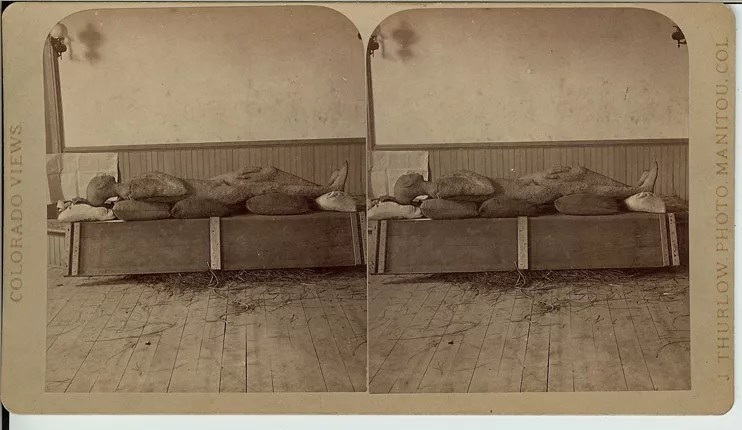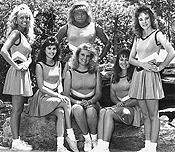
John Moore/Getty Staff

Audio By Carbonatix
Those creepy drones flying over the eastern plains of Colorado may have fallen off the radar lately, but that doesn’t mean the mystery has been solved. Officials with more than seventy local, state and federal agencies, including the military and the FBI, met at a closed-door briefing in the town of Brush on January 6, but more than two weeks later, there are still more questions than answers about the sightings.
Visitors from another land? Top-secret Air Force maneuvers? Or just a good, old-fashioned hoax, like the ones that have hovered over so much of Colorado’s history? Through the years, there have been swindlers both great (Silverado) and small (Soapy Smith), crop circles and cattle mutilations, and people impersonating everyone from an Arabian prince to Donald Trump’s niece.
D.C. Oakes may have been Colorado’s first hoaxer; after failing to find gold in California a decade earlier, he arrived in what would become Denver in October 1858, then the next year published the Pike’s Peak Guide & Journal pamphlet, in which he promised would-be fortune hunters that “the whole country between the Cache la Poudre and Cherry Creek is a beautiful rich valley full of mountain streams of living water and exceedingly rich in gold.” It wasn’t.
Among those who came west with high hopes was young Sam Clemens, who later wrote that he expected to see “masses of silver lying all around the ground...glittering in the sun on the mountain summits.” Instead, he ultimately found his fortune writing as Mark Twain.
Will you step up to support Westword this year?
At Westword, we’re small and scrappy — and we make the most of every dollar from our supporters. Right now, we’re $23,000 away from reaching our December 31 goal of $50,000. If you’ve ever learned something new, stayed informed, or felt more connected because of Westword, now’s the time to give back.
Others chose the path of faking success. Here are ten classic Colorado hoaxes:
The Diamond Farm
In the 1870s, a group of European swindlers fired uncut African diamonds into the ground on a remote mountain acre near Middle Park, taking samples to San Francisco to get them “appraised.” Soon they had half a dozen eager investors in their “diamond field,” and a stock company was formed after a representative followed the fake miner back to his Colorado field, where diamonds were winking out of the dirt. “Gathering in something like $800,000 and one-fourth of the stock, which they afterwards disposed of in New York, the sharpers skipped,” a newspaper reported. One conspirator was later arrested but released for lack of evidence. It took a geologist conducting a survey, Clarence King, to expose the “diamond farm” hoax; it’s commemorated by Diamond Peak in Moffat County. The Solid Muldoon. Denver Public Library
The Solid Muldoon
While picnicking on September 20, 1877, William A. Conant of Colorado Springs found a foot-like stone rising out of the ground, and dug until he’d unearthed a stone giant that weighed 450 pounds and was more than seven feet tall. It also had a two-inch tail. Marveled the Denver Daily Times, “There can be no question about the genuineness of this piece of statuary.” The petrified man was named the Solid Muldoon after a nearby hill or a famous boxer. P.T. Barnum, who displayed what became known as the Solid Muldoon in his circus, told the Kansas City Times that the Muldoon was “in my candid opinion the missing link which Darwin claims connects mankind with the beast creation. It is certainly the petrified body of a man with a tail.” But the Solid Muldoon was actually made of cement, and when the truth was revealed, Barnum was suspected of masterminding the scheme.
Chicken Bill
The most celebrated of the mine salters, William Lovell, aka “Chicken Bill,” even aged bits of brass under a waterfall for a plausibly dull-gold finish. Although he was one of the earliest residents of Leadville, Chicken Bill had apparently lacked what his fellow miners called “a smell of ore” and abandoned earnest digging in favor of making simulated riches. But he remained best known for his defeat by a proven mining man, Horace Tabor, who at the time sold supplies and served as mayor of Leadville while holding grubstakes in several of its successful claims. Bill stole silver from a mine in which Tabor had a share, the Little Pittsburgh, and loaded it into the bottom of his own dig site in Leadville to sell to him. After discovering the borrowed ore in his new property, Tabor dug past the fraud and found a rich strike that became the Chrysolite mine. Bill died destitute in 1886.
The Great Wall of China
On June 25, 1899, four Denver newspapers (the Denver Post, the Rocky Mountain News, the Republican and the Denver Times, just a sampling of the papers in the city at the time) reported that the Chinese government was going to tear down part of the Great Wall of China and use the rock to build roads. The news traveled fast, and papers across the country picked up the story. Unfortunately, it wasn’t true. Four Denver reporters – Al Stevens, Jack Tournay, John Lewis and Hal Wilshire – had invented the story while drinking at the Oxford Hotel on a slow news day.
The Green Monster
In May 1954, Denver was under attack by the Green Monster of Plum Creek, according to the Denver Post. Three Littleton men reported that they’d seen a giant green figure tossing a chicken in the air and acting like a wild man. As sightings continued, a crowd of at least 2,000 people searched for the Green Monster, which continued to destroy fences and trample gardens. Finally, the Douglas County Sheriff’s Office found the man who’d perpetrated the hoax; he remains nameless to history.

Charles Daugherty (center) as a high-school cheerleader.
Westword
The Gang’s All Cheer
Born on June 1, 1964, Charles James Daugherty was a “perfectly normal” kid, according to his father, one who became a true con man posing as a woman. In 1989, billing himself as Shannon Ireland Trump, niece of Donald Trump, Charles joined the all-woman cheerleading squad of the now-defunct Colorado Springs Spirit football team. After that, Charles enrolled at Coronado High School in Colorado Springs as seventeen-year-old Cheyen Weatherly, again making the cheerleading squad before he was arrested for criminal impersonation. After confessing, Charles was given probation and said he planned to continue living life as a woman. Now billing himself as Shannon Ireland (half-sister of model Kathy Ireland), Charles continued shaking down marks as he planned the ultimate models’ “Millenium Tour 2000,” until he was again arrested in 2000 and charged with theft and fraud. Still, as con or cover girl, this hoaxer had legs.
John Mark Karr
By 2006, everyone was desperate to find out who’d killed JonBenét Ramsey ten years earlier. But Mary Lacy, then the district attorney of Boulder, got a little too desperate. Hearing from then-University of Colorado professor Michael Tracy that he’d been corresponding with a man in Thailand who’d confessed to murdering JonBenét, Lacy consulted with authorities there, who arrested Karr and placed him in a Bangkok jail. There Karr, who was in the middle of what was then called sex-reassignment surgery, told anyone who would listen that he was “with JonBenét when she died.” Lacy brought Karr to Boulder, where there were plenty of people willing to listen, and it was quickly determined that Karr could not have killed the little girl. After his release, he later resurfaced in Atlanta as a woman going by the name Alexis Valoran Reich, and announced on his résumé that “my passion is my work with children.”
The Sham Shah
On September 29, 2000, a man calling himself Ali Patrik Pahlavi arrived in Denver on the train and headed straight for the LoDo Inn, a bed-and-breakfast near Union Station that today is the Nativ Hotel. His luggage and $12,000 had been stolen, Pahlavi told the hotel’s owner, former FBI man Tom Broemmel. Could Broemmel possibly give him a room for the night and loan him $500? He was good for it, Pahlavi promised; after all, he was the billionaire nephew of the late Shah of Iran. Broemmel agreed. Two days later, Pahlavi was back with another proposal: His company, Eagle Spirit Investments, was going to build a twenty-story, 500-room hotel in downtown Denver. Perhaps Broemmel might like to invest? The rest of the money would be coming soon – and in the meantime, Pahlavi would need a place to stay. What followed were two of the wildest months in LoDo history – and that’s saying something, since a century before, this part of town was the jumping-off point for some of the biggest con men in the West, including the legendary Soapy Smith. Waitresses at the nearby Dixons restaurant were the first to suspect there was something up with Pahlavi, whom they started calling “the con man formerly known as Prince.” By the end of that November, even Broemmel had caught on. Pahlavi was arrested and charged with theft and defrauding an innkeeper.
Stolen Valor
“Let me address some relevant background info,” then-35-year-old Rick Strandlof wrote on his Facebook page in 2012. “The majority of the last twenty or so years has involved me lying, deceiving, cheating or in general being a terrible human being.” Some of that time, he was a human being known as Rick Gold, a devoutly Jewish attorney. He also went by Rick Pierson, a name half his own and half his stepfather’s. But his most infamous creation was Rick Duncan, a seriously injured Marine captain with a Purple Heart, a Silver Star and PTSD who’d allegedly survived 9/11. Duncan’s story, which regularly prompted tears from his own eyes and those of others when he told it around Denver, earned him credibility with vets, politicians and law enforcement as he volunteered to raise money and awareness for veteran causes. In 2008, Strandlof was uncovered as a fraud and charged with violating the 2006 Stolen Valor Act, which prohibited lying about military service. But he got lucky: In June 2012, the U.S. Supreme Court rejected Stolen Valor, ruling that the law violated the First Amendment’s guarantee of freedom of speech, and the charges against Strandlof were dropped.
Balloon Boy
On October 15, 2009, people around the world held their breath when they heard that six-year-old Falcon Heene, the son of Richard and Mayumi Heene of Fort Collins, was trapped inside a silver flying saucer, a homemade helium balloon that had escaped into the skies. National Guard helicopters and police cars pursued the balloon, which flew for more than an hour and finally landed about a dozen miles from Denver International Airport. The boy was not aboard; he was later found hiding in the family’s attic. In an interview with Wolf Blitzer that night, after being asked whether he’d heard his parents calling for him, Falcon turned to his father and said, “You guys said that, um, we did this for the show.” A few weeks later, both Richard Heene and Mayumi were charged in connection with the hoax and ordered to 90 and 20 days in jail, respectively. Falcon and his brothers later formed a rock band.
Special thanks to Nathan Ward for digging into mining scams, as well as Westword writers who profiled some of Colorado’s classic scam artists.